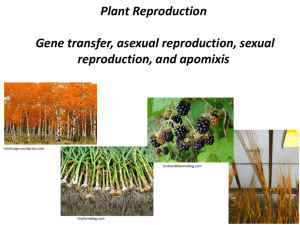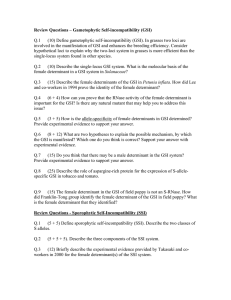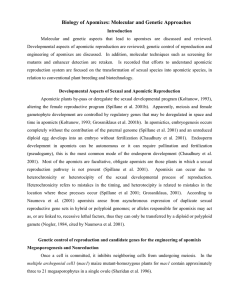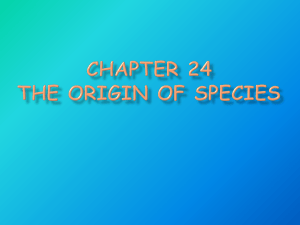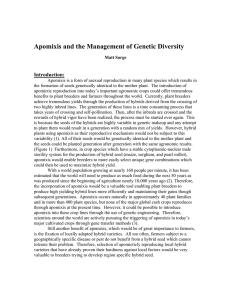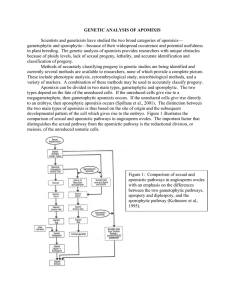Powerpoint
advertisement
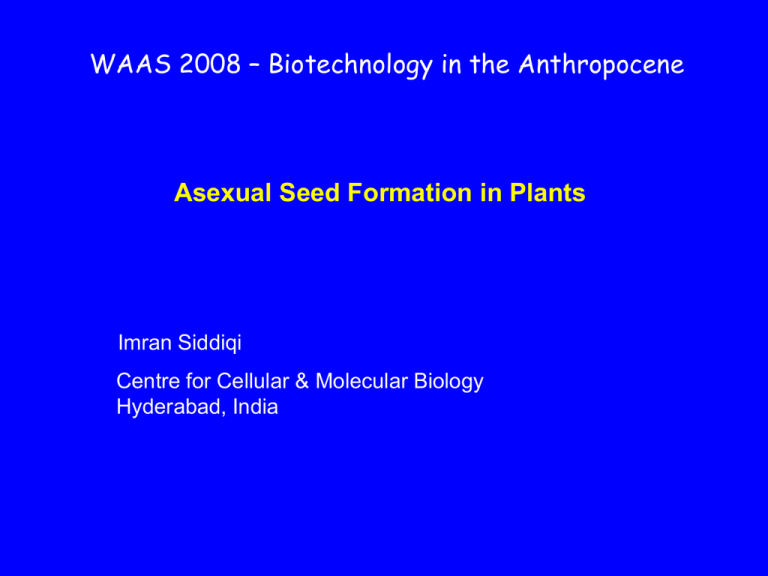
WAAS 2008 – Biotechnology in the Anthropocene Asexual Seed Formation in Plants Imran Siddiqi Centre for Cellular & Molecular Biology Hyderabad, India The Sexual Life Cycle 1n Gametes 2n 2n Zygote Adult Seeds Apomixis: Asexual Seed Formation Asexual Reproduction in Animals: Parthenogenesis • Asexual Reproduction Occurs Under Conditions Where Sexual Reproduction is Unfavourable • The Capacity for Asexual Reproduction is Embedded in Sexual Organisms and Has Adaptive Value Apomixis – Seed Development Without Meiosis and Fertilization Apomeiosis – Formation of an unreduced female gamete (egg). Parthenogenesis – Development of the egg cell into an embryo without fertilization by sperm. Potential For Apomixis in Plant Breeding: • Fixation of genetic character in successive generations Hybrid Vigour: Hybrids Show Increased Vigour But Don’t Breed True Parent 2 X Parent 1 Hybrid P1 F1 P2 Hybrid Vigour Wheat 10-15% Rice 20-25% Selection, Inbreeding Apomixis Would Fix Hybrid Vigour Over Successive Generations Parent 1 X P1 Hybrid P2 P1 F1 Parent 2 P1 P2 P1 P2 Potential for Apomixis in Plant Breeding: Fixation of genotype (hybrid vigour) – Nawaschin and Karpachenko (1930) • Reduced cost of hybrid seed production • Successive progagation of hybrids • Accelerated breeding • Encourage “risk” in breeding practice Value of Apomixis Hybrid Vigour Wheat 10-15% Rice 20-25% Apomixis is rice: 3.4 b$ /yr Strategies for Transfer of Apomixis To Food Crops: Apomixis is a modified sexual pathway Genes from sexual plants Mutation in a gene called DYAD shows female sterility Normal dyad mutant Seeds produced by dyad have an extra set of chromosomes (triploid)and arise from fertilization of an unreduced (Apomeiotic) female gamete Triploid (3n = 15) mitosis No. of plants: meiosis 17 Diploid (2n = 10) mitosis meiosis 2 Conclusion: Proof of principle demonstration for generating a functional component of apomixis (apomeiosis) in a sexual plant by altering a gene of known molecular identity – a first step towards synthesis of apomixis in crops Credits: Maruthachalam Ravi Bhavna Agashe V. Subbiah Gopal Ganesh CCMB Funding: CSIR; Department of Biotechnology; Mohan P. Anand
